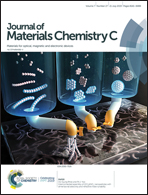Poly(ethylene oxide)-assisted energy funneling for efficient perovskite light emission†
Abstract
Poly(ethylene oxide) (PEO) has been demonstrated as an effective polymer additive for fabrication of organic–inorganic hybrid perovskite light emitting devices due to its properties enabling pinhole-free film morphology, improved charge injection, and defect passivation. In this paper, we report a new aspect of PEO in assisting the energy funneling in formamidinium lead bromide (FAPbBr3) thin films, leading to a very high photoluminescence quantum yield of ∼62.1%. By mixing PEO with FAPbBr3 at a desired ratio, self-assembled 3D polycrystals with sizes from ∼20 to ∼1500 nm were formed. The polycrystals contain inhomogeneous domains with a range of energetic excited states. Through fluorescence lifetime image microscopy, the in situ fluorescence emissions and the lifetimes of the domains were measured simultaneously, indicating energy funneling from the wide-bandgap domains (with small-size grains) into the narrow-bandgap domains (with large-size grains). PL spectroscopy on the nano-second scale was used to study the dynamics of charge transfer, which shows a reduced short-wavelength emission and narrowed full width at half maximum with increasing time. Our results also indicate that the optimal PEO doping ratio of 0.35 : 1 can facilitate the most efficient charge carrier cascade for energy funneling. This study establishes the role of PEO-assisted energy funneling avoiding the defect-quenching effect in perovskites, for potential applications in perovskite LEDs and lasers.



 Please wait while we load your content...
Please wait while we load your content...